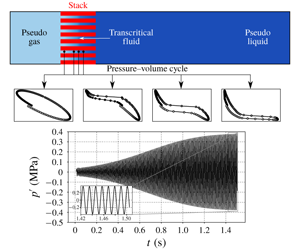Article contents
Real-fluid effects on standing-wave thermoacoustic instability
Published online by Cambridge University Press: 25 November 2019
Abstract

We have performed high-order compressible Navier–Stokes simulations of a thermoacoustically unstable resonator employing  $\text{CO}_{2}$ in transcritical conditions. The parameter space spans the range of base pressures
$\text{CO}_{2}$ in transcritical conditions. The parameter space spans the range of base pressures  $p_{0}=1.01-1.5\,p_{cr}$ and temperature differences
$p_{0}=1.01-1.5\,p_{cr}$ and temperature differences  $\unicode[STIX]{x0394}T=T_{hot}-T_{cold}$ up to 200 K, with thermodynamic and transport properties obtained from the Peng–Robinson equation of state and Chung’s model. The set-up is a classic standing-wave thermoacoustic resonator, which has been optimized resulting in a minimum temperature difference required to sustain the instability of 23 K. Strong real-fluid effects in the thermoacoustic response in the linear regime are observed: (i) the thermoviscous functions need to depend on the complex eigenvalue (and not just the angular frequency) for linear theory to accurately predict the growth rate observed in the Navier–Stokes simulations, due to a high growth-rate-to-frequency ratio; (ii) the growth rate and frequency vary in a non-monotonic fashion with respect to
$\unicode[STIX]{x0394}T=T_{hot}-T_{cold}$ up to 200 K, with thermodynamic and transport properties obtained from the Peng–Robinson equation of state and Chung’s model. The set-up is a classic standing-wave thermoacoustic resonator, which has been optimized resulting in a minimum temperature difference required to sustain the instability of 23 K. Strong real-fluid effects in the thermoacoustic response in the linear regime are observed: (i) the thermoviscous functions need to depend on the complex eigenvalue (and not just the angular frequency) for linear theory to accurately predict the growth rate observed in the Navier–Stokes simulations, due to a high growth-rate-to-frequency ratio; (ii) the growth rate and frequency vary in a non-monotonic fashion with respect to  $p_{0}$ and
$p_{0}$ and  $\unicode[STIX]{x0394}T$; (iii) the pressure eigenmode amplitude tends to flatten out, and the pressure–velocity phase difference smoothly transitions from
$\unicode[STIX]{x0394}T$; (iii) the pressure eigenmode amplitude tends to flatten out, and the pressure–velocity phase difference smoothly transitions from  $\unicode[STIX]{x03C0}/2$ to
$\unicode[STIX]{x03C0}/2$ to  $-\unicode[STIX]{x03C0}/2$ at the average pressure node location; and (iv) the sharp change in base acoustic impedance at transcritical conditions introduces a discontinuity in the eigenmodes’ spatial derivative. The energy budgets illustrate, for a given
$-\unicode[STIX]{x03C0}/2$ at the average pressure node location; and (iv) the sharp change in base acoustic impedance at transcritical conditions introduces a discontinuity in the eigenmodes’ spatial derivative. The energy budgets illustrate, for a given  $\unicode[STIX]{x0394}T$, the increase of the acoustic power produced, but also of the heat input required, for thermodynamic conditions approaching the critical point. Finally, intense mass transport events at transcritical conditions are shown to entail thermodynamic and convective nonlinearities, which do not, however, govern the limit cycle physics, dominated instead by nonlinear minor losses.
$\unicode[STIX]{x0394}T$, the increase of the acoustic power produced, but also of the heat input required, for thermodynamic conditions approaching the critical point. Finally, intense mass transport events at transcritical conditions are shown to entail thermodynamic and convective nonlinearities, which do not, however, govern the limit cycle physics, dominated instead by nonlinear minor losses.
JFM classification
- Type
- JFM Papers
- Information
- Copyright
- © 2019 Cambridge University Press
References
- 19
- Cited by




